by King's Nursery | Nov 6, 2023 | Front Page News, General
It’s that time of year- fragrant Daphne are here!
We have lots of these old-fashioned beauties in stock right now!
I can’t get enough of the potently fragrant flower clusters, reminiscent of citrus blooms. Mmmmm- heavenly! I cut new bouquets every few days, putting them where the scent can be enjoyed the most. I’ll even bring some along when I go to visit friends and neighbors- perfect little hostess gifts.
Plant it in a spot that gets partial sun. Use Master Nursery Planting Mix straight out of the bag for containers, or mix it 50/50 with the native soil back into the hole. Don’t forget the Masterstart- it gets those roots growing quick.
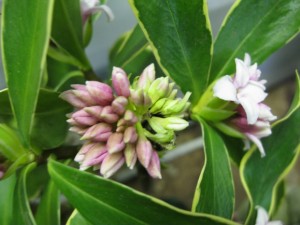 There are more reasons to love this old-fashioned beauty than just the flowers:
There are more reasons to love this old-fashioned beauty than just the flowers:
Deer resistance. This is one plant that is reliably impervious to deer, regardless of where you live. Yay! No fences or sprays needed!
Drought tolerance. Not only is daphne tolerant of drought, but it prefers low water (especially in the summer months). Wow, no problem- I like to keep that water bill down.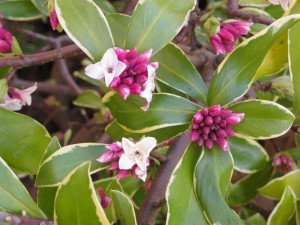
Evergreen. The glossy leaves are showy on their own, true green with nicely contrasting cream margins. Each leaf is somewhat different than the next, so you’ll see variations in the pattern of color. It really pops next to deeper tones- I have it against a dark wooden fence.
Daphne is a moderate grower, topping out at about 4’X4′ over time. It does well in a fair amount of shade, but also in a fair amount of sun, so where you plant will perhaps depend more on daphne’s water needs than the sun exposure. I have mine planted beside my front walkway, to best enjoy the delicious fragrance.
We have a great selection of nice and healthy daphne plants right now, so stop by.

Hello, Gorgeous!
by King's Nursery | Nov 13, 2019 | General
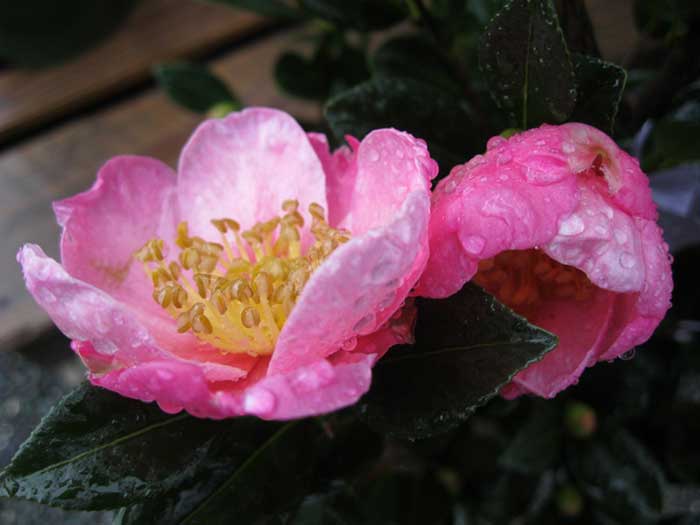
‘Pink-a-Boo’ camellia sasanqua
Boy, are we tending to some hogs right now…….
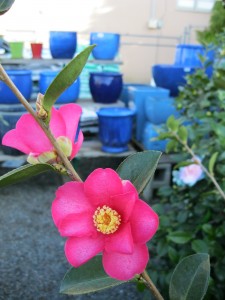
sasanqua perfection- ‘Kanjiro’
This crop of camellias are extra-vigorous, dark green and glossy, with plentiful buds that are starting to pop open. Back in the day these types of plants were called hogs, due to their voracious growth, robust size and top notch quality.
You can get the best selection right now, no slop required.
This is an ideal time to plant camellias. The roots will fill in nicely during these winter months, providing ample support for the plentiful flowers and new growth of the season ahead.
Use some Planting Mix straight out of the bag when you plant in pots, or incorporate Paydirt along with Planting Mix 50/50 with your native soil when installing them in the ground. It’s important to include a starter fertilizer or camellia food into this mix as well, so as to put nutrients right near the roots; this will encourage strong, fast-growing new roots to form.
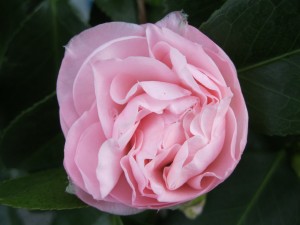
‘Debutante’ camellia japonica, just starting to open
Camellias are low maintenance and fairly drought tolerant once established. There are different types available to suit different planting sites- japonicas are generally shade-loving, while sasanquas will accept full sun as well as shade. Some, like the statuesque reticulatas, grow upright and tall, while others are meant to stay shorter and wider without trimming. Many will sport large, showy flowers, while others bear prolific clusters of bloom. We even have specialty espalier specimens on trellis and topiary tree camellias.
They’re one of those plants that is really versatile. I’ve seen them grown as a flower-filled hedge, as a stately specimen allowed to assume it’s natural form, even potted with colorful bedding plants beneath. I also enjoy cutting branches for flower arrangements, or floating a large blossom or two in a bowl on the table.
So if you’re hankering for a new hog, come take a peek in our pen………
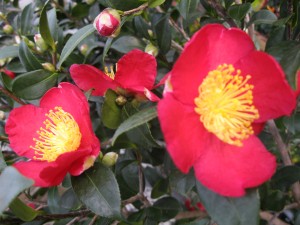
‘Yuletide’ blooms just in time for the holidays
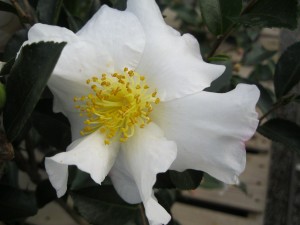
‘Setsugekka’ camellia sasanqua
by King's Nursery | Sep 2, 2019 | General, How-to Info

At Kings we just love sweet peas mostly because they do a bunch of things. They are reasonably easy, they grow during the cooler months, they can climb or ramble, they are very cut-able and they smell wonderful. Here are a few tips on sweet peas so you can have fun and success.
When to plant: As mentioned, Sweet Peas like the weather on the cool side, on the other hand, they need a bit of warmth to germinate and eventually bloom. In Sonoma County you may direct seed into the prepared soil in August, September and October. This gives the plants time to sprout before it gets cold. Normal frosts will not kill the plants. Indeed, during the cool winter, the roots continue to grow providing strength in very early Spring. If you have missed the direct seeding time, you may start them indoors and plant them outside anytime during the Winter and all the way through early Spring.
Location: Full Sun to no less than half a day of full sun.
Germination: Most folks find this pretty easy. In the ground, care should be taken to prepare the soil deeply, to about 12” or more if you are energetic. After working the soil, add Master Nursery Pay Dirt and Master Start and work again. Water so the soil is moist, not soggy and plant the seeds about an inch deep.
Keep evenly moist, but not soggy. Over watering can rot them. Another method would be to prepare the bed early and plant the seeds right when the Winter rains are starting. For indoors we use Master Nursery Potting soil right out of the bag, filling a six pack, small pots or greenhouse/flat kits designed for starting seeds. Again the seed is placed about an inch deep and watered several times thoroughly. Water thoroughly again when it is dry. There is no need for daily water, only when necessary. Germination can happen as soon as 7 days. Once sprouted, put them in a sunny location until the sprouts are a couple of inches tall, then outside to a sheltered spot, then into the garden or containers. Some folks soak the seed overnight before planting, we find that this is generally not necessary.
Growing: Most sweet peas need a structure. The exceptions are dwarf and knee high varieties, which can be grown with or without support and even in hanging baskets and on the sides of containers if you do not mind the sprawling look. Your structure can be as plain or as fancy as you like, but please make it sturdy and a bit bigger than you think that it ought to be. We have used bamboo hoops for smaller varieties, or redwood stakes for full sized ones. We have also attached a trellis to a large container with great success. Whatever the method you choose, remember that when the young peas reach out for support, they will need to be gently tied, especially at first and in a timely manner. As the stems age they can become a bit brittle, making the job difficult. We find that once they are started out on the right track they keep on track fine just by themselves. Spacing for new plants should be about 6 to 8 inches apart in your prepared soil. Please remember to work the soil. Your ultimate results are always tied to the soil. Subsequent feeding can be any complete food. We recommend slow release Osmocote or Master Nursery Multi Purpose. Whichever you choose, please do it. Those nasty snails can be a problem when your plants are young and defenseless. Put down plenty of Sluggo Plus to make sure all the crawling critters stay away.
Other Stuff: Keep the flowers cut. This is important and fun. Sweet peas are cool season annuals and will produce armloads of flowers if you cut the spent ones off as soon as they start to drop petals. This will provide you with non-stop bouquets with room-filling fragrance, and will bloom for weeks and weeks. As the weather warms in Spring, please water your peas consistently as this will also increase length of bloom.
 There are more reasons to love this old-fashioned beauty than just the flowers:
There are more reasons to love this old-fashioned beauty than just the flowers:






